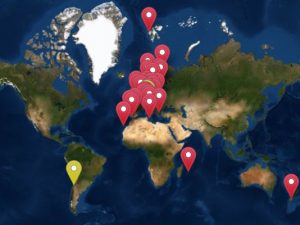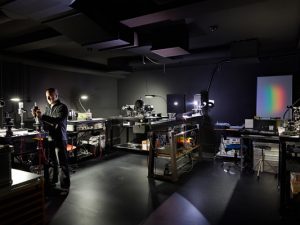ULTRAVIOLET RADIOMETRY
UV Radiometer Calibration Services
Various radiometer calibration services are offered by the WCC-UV Section at PMOD/WRC. These include: i) Site audits with the QASUME travel spectrometer, ii) irradiance standard . . .
QASUME Site Audits
QASUME is a travel reference UV spectro-radiometer which allows intercomparison campaigns of global solar irradiance measurements from different instruments to be . . .
Optics Laboratories
Three optics laboratories are available to comprehensively characterise radiometers, each run by the Sections: Solar Radiometry (SRS), UV Radiometry (WCC-UV) and WORCC.
Current Measurements
Daily measurements of UV, solar irradiance and meteorological parameters are available from the PMOD/WRC and the Weissfluhjoch, Davos.
International UV Comparisons
A number of comparisons of spectral UV measuring devices have been organised in the past. The longest history of mostly bilateral comparisons have been carried out . . .
History of UV Measurements in Davos
Professor Carl Dorno, who’s main interest was solar radiation and its relation to bio-climatological effects, investigated the very short wavelength part of solar radiation . . .
The objectives of the World Calibration Center for UV (WCC-UV) are to assess the data quality of the Global GAW UV network, and to harmonise UV measurements from around the world.
A GAW regional UV calibration center for the European region (WMO RA VI, Europe) was established on 1 January 2008 at PMOD/WRC. Its main function is to ensure that the data submitted to the GAW World UV Data Center (WOUDC) operated by the Meteorological Service of Canada in Toronto is of known and adequate quality to meet the needs of the scientific community.
By its activities, the European Ultraviolet Calibration Center aims to improve data quality in the European GAW UV network and to harmonise the results from different stations and monitoring programs in order to ensure representative and consistent UV radiation data on a European scale. As of 1 January 2013, the PMOD/WRC was recognised as a World Calibration Center for UV (WCC-UV) radiation by the WMO, Global Atmosphere Watch Programme.
- Assist WMO Members operating WMO/GAW stations to link their UV radiation observations to the WMO/GAW Reference Scale through comparisons of the station instruments with the standard instruments operated by PMOD/WRC.
- Assist the WMO/GAW Scientific Advisory Group (SAG) on UV radiation in the development of the quality control procedures required to support the quality assurance of UV observations and ensure the traceability of these measurements to the corresponding primary standard.
- Maintain a set of reference irradiance standards and ensure their traceability to the SI units through purchase and intercomparison of transfer standards traceable to primary irradiance standards held at National Metrological Institutes (NMIs).
- Maintain and operate a transportable reference spectroradiometer for the routine quality assurance and calibration of spectroradiometers measuring spectral solar UV irradiance through regular site visits.
- Maintain and operate instrumentation to provide calibration facilities for UV radiation radiometers (spectral and broadband).
- Provide traceability to the primary spectral irradiance standards of NMIs by calibrating spectral irradiance standards of UV monitoring laboratories.







